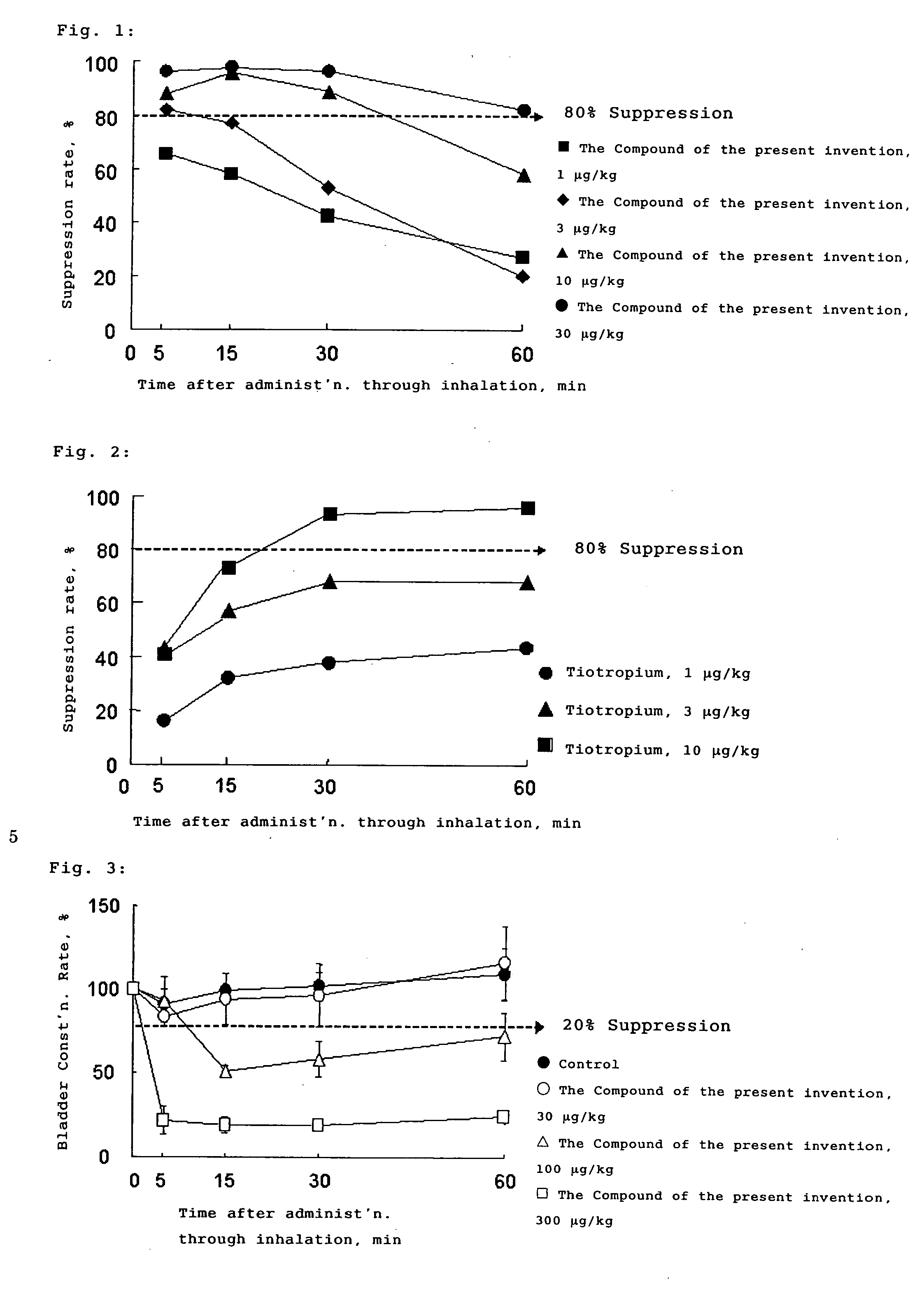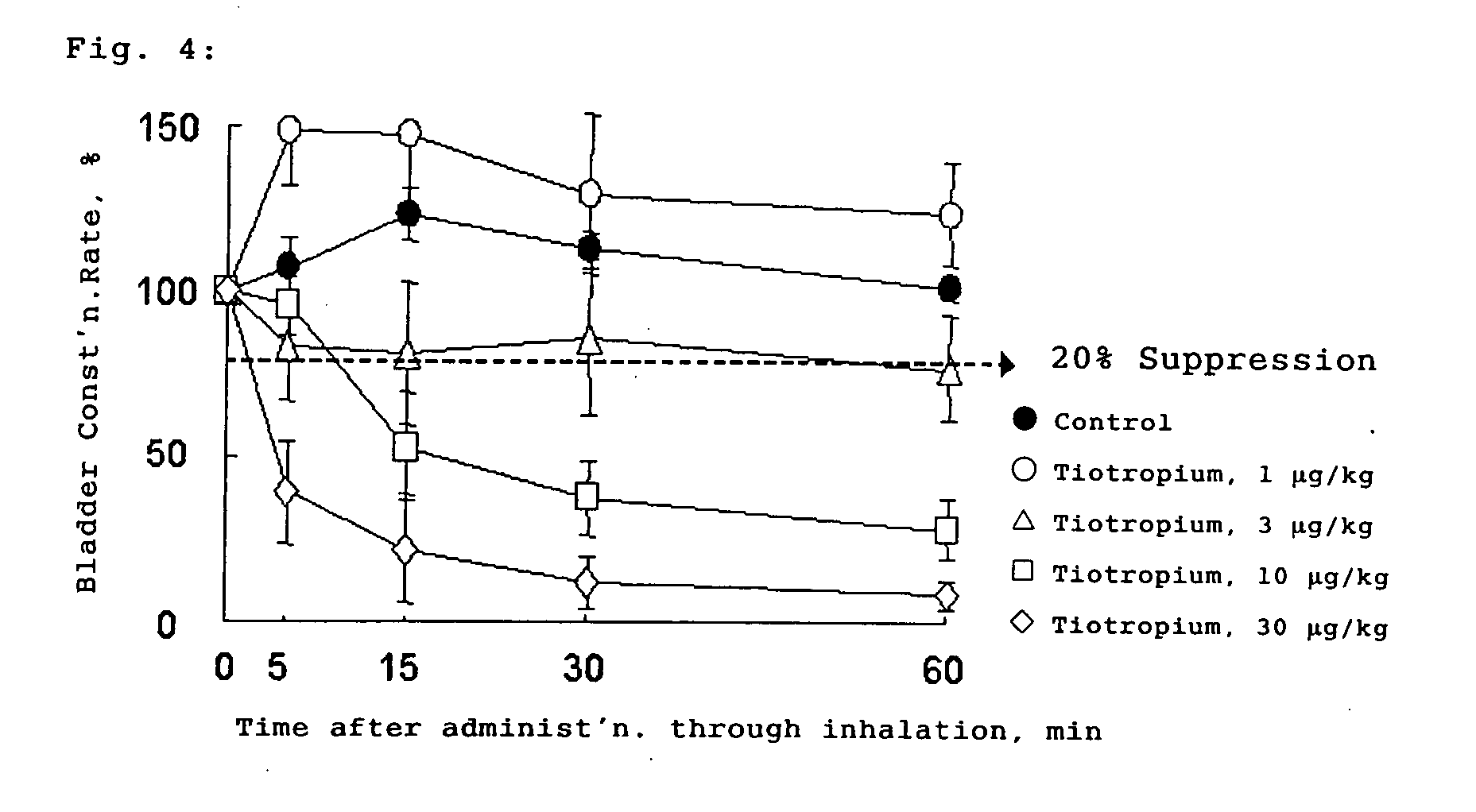Tropane Compounds and Pharmaceutical Compositions Comprising the Same as an Active Ingredient
a technology of active ingredients and compounds, applied in the direction of heterocyclic compound active ingredients, drug compositions, biocide, etc., to achieve the effects of reducing side effects or adverse reactions, and reducing the number of active ingredients
- Summary
- Abstract
- Description
- Claims
- Application Information
AI Technical Summary
Benefits of technology
Problems solved by technology
Method used
Image
Examples
example 1
Ethyl (2E)-3-(4-formylphenyl)acrylate
[0213] Added to a N,N-dimethylformamide solution (80 mL) of 4-formylcinnamic acid (2.9 g) were potassium carbonate (2.27 g) and ethyl iodide (1.4 mL), followed by stirring at room temperature for 5 hours. The reaction mixture was charged in water, and extraction was effected with ethyl acetate. The organic layer was washed with water and an aqueous saturated sodium chloride solution, dried over anhydrous sodium sulfate and concentrated. The resultant residue was purified on a silica-gel column chromatography (n-hexane:ethyl acetate=4:1) to give the subject title compound (1.45 g) showing the following physico-chemical values:
[0214] TLC: Rf 0.51 (n-hexane:ethyl acetate=4:1);
[0215]1H-NMR (CDCl3): d 1.35, 4.29, 6.55, 7.64-7.76, 7.91, 10.03.
example 2
Ethyl 3-[4-(hydroxymethyl)phenyl]propanoate
[0216] 10% Palladium carbon (70 mg) was added to an ethanol solution (15 mL) of the compound (1.44 g), as produced in Example 1, under an argon atmosphere, followed by stirring at room temperature for 4 hours under a hydrogen atmosphere. The reaction mixture was filtered through Cellite®, and the filtrate was concentrated. The resultant residue was purified on a silica-gel column chromatography (n-hexane:ethyl acetate=4:1) to give the subject title compound (1.35 g) showing the following physico-chemical values:
[0217] TLC: Rf 0.12 (n-hexane:ethyl acetate=4:1);
[0218]1H-NMR (CDCl3): d 1.24, 1.61, 2.61, 2.95, 4.13, 4.66, 7.20, 7.29.
example 3
Ethyl 3-[4-(bromomethyl)phenyl]propanoate
[0219] Carbon tetrabromide (1.27 g) and triphenylphosphine (805 mg) were added to a methylene chloride solution (5 mL) of the compound (533 mg) as produced in Example 2, followed by stirring at room temperature for 30 min. An aqueous saturated sodium hydrogencarbonate solution was added to the reaction mixture, and extraction was effected with ethyl acetate. The organic layer was washed with an aqueous saturated sodium chloride solution, dried over anhydrous sodium sulfate and concentrated. The resultant residue was purified on a silica gel column chromatography (n-hexane:ethyl acetate=9:1) to give the subject title compound (667 mg) showing the following physico-chemical values:
[0220] TLC: Rf 0.61 (n-hexane:ethyl acetate=4:1);
[0221]1H-NMR (CDCl3): d 1.23, 2.61, 2.94, 4.13, 4.48, 7.18, 7.32.
PUM
| Property | Measurement | Unit |
|---|---|---|
| Solvation | aaaaa | aaaaa |
Abstract
Description
Claims
Application Information
 Login to View More
Login to View More - R&D
- Intellectual Property
- Life Sciences
- Materials
- Tech Scout
- Unparalleled Data Quality
- Higher Quality Content
- 60% Fewer Hallucinations
Browse by: Latest US Patents, China's latest patents, Technical Efficacy Thesaurus, Application Domain, Technology Topic, Popular Technical Reports.
© 2025 PatSnap. All rights reserved.Legal|Privacy policy|Modern Slavery Act Transparency Statement|Sitemap|About US| Contact US: help@patsnap.com



